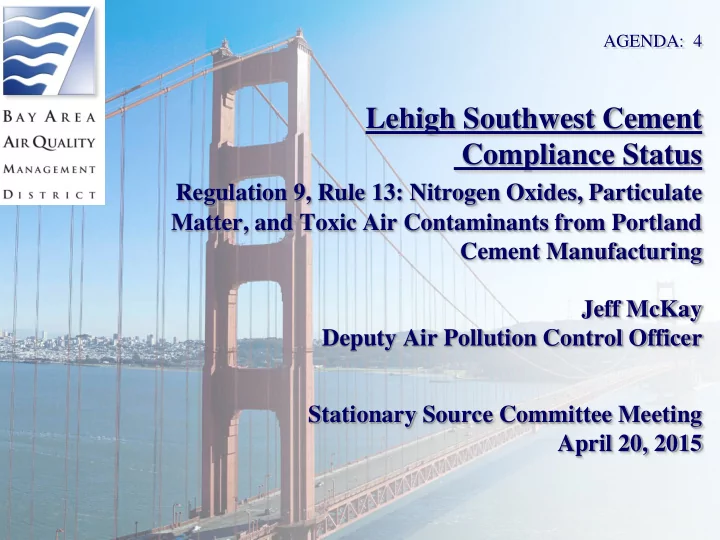

AGENDA: 4 Lehigh Southwest Cement Compliance Status Regulation 9, Rule 13: Nitrogen Oxides, Particulate Matter, and Toxic Air Contaminants from Portland Cement Manufacturing Jeff McKay Deputy Air Pollution Control Officer Stationary Source Committee Meeting April 20, 2015
Outline Facility Description Sources and Emissions Description Rule 9-13 Requirements Compliance Status Health Risk Assessment (HRA) Future Changes to HRA Risk Basis 2
Background Lehigh Southwest Cement Plant is located in unincorporated Cupertino at the end of Stevens Creek Boulevard Regulation 9, Rule 13 effective September 9, 2013 The Rule sets emission limits for NOx, PM and Toxic Air Contaminants (TACs) 3
Facility Location 4
Lehigh Southwest Cement Plant Limestone is quarried, crushed, and combined with other raw materials in a high temperature kiln system to produce “clinker” Clinker is cooled, ground, and mixed with gypsum to produce Portland cement Facility also produces and sells aggregates 5
Manufacturing Process Kiln Stack Packing Crusher Crusher Quarry Preheat Tower Raw Baghouses Mill Bulk Coke Mill Loading Cement Silos Cooler Coke Bin Crusher Stack Gypsum Kiln Cement Mills Blending Cooling and Storage Clinker Store Schematic Diagram of Lehigh Cement Plant 6
Emission Points Quarry – Particulate Matter Crushers – Particulate Matter Kiln Stack – Particulate Matter (PM) Nitrogen Oxides (NOx) Sulfur Dioxides (SO 2 ) Precursor Organics (POC) Hydrochloric Acid (HCl) Mercury (Hg) Hexavalent Chromium (Cr 6+ ) Cooler Stack – Particulate Matter (Cr 6+ ) Material Storage – Particulate Matter (Cr 6+ ) 7
Elements of Rule 9-13 Emissions Standards Toxic Air Contaminants (mercury, hydrochloric acid, others) NOx standard of 2.3 pounds per ton of clinker PM standard of 0.04 pounds per ton of clinker Ammonia standard of 10 ppmv above baseline Stack Requirements Configuration ensures health protections as demonstrated by Health Risk Assessment (HRA) Continuous monitoring Fugitive dust mitigation control measures 8
Regulation 9-13 Emissions Limits/Monitoring Source Pollutant Emission Limit Monitor Kiln & Clinker Particulate Matter (PM) 0.04 lb/ton clinker, 3-run test avg. PCEM/ Cooler Source Test Kiln Nitrogen Oxides (NOx) 2.3 lb/ton clinker, 30-day rolling avg. CEM Kiln Ammonia (NH3) 10 ppmv @ 7% O 2 above the baseline emission CEM levels Kiln Dioxins/Furans (D/F) 0.2 ng-TEQ/dscm @ 7% O 2 , 24-hr rolling avg. PCEM/ Temperature Kiln Mercury (Hg) 55 lb/million ton clinker, 30-day rolling avg. CEM Kiln Total Hydrocarbon (THC) 24 ppmv THC or 12 ppmv HAP @ 7% O 2 , 30-day CEM rolling avg. Kiln Hydrogen Chloride (HCl) 3 ppmv @ 7% O 2 , 30-dayrolling avg. CEM Initial testing is required for all pollutants within 30 days of operation after September 9, 2013 CEM = Continuous Emission Monitor, PCEM = Parametric Continuous Emission Monitor 9
Emissions Control Reg. 9-13 Requirements Compared to 2010 Emission Levels Pollutant % Reduction Nitrogen Oxides (NOx) ~ 42% Particulate Matter (PM) ~ 10% Precursor Organics (POC) ~ 90% Hydrochloric Acid (HCl) ~ 70% Mercury (Hg) ~ 93 % Benzene ~ 90% Source: July 2012 Staff Report for BAAQMD Regulation 9-13 10
New Kiln and Cooler Stacks Cooler Stack Kiln Stack 11
New Kiln & Cooler Stack Locations 12
Control Technologies Utilized New Kiln and Clinker Cooler Stacks to comply with Rule 9- 13’s Stack and HRA requirements Dry lime injection system (HCl, SO 2 ) SNCR enhancement (NOx) Activated carbon injection system (Hg, HAPs) Baghouse improvements (PM) 13
Kiln Stack Monitoring Continuous Emission Monitors installed Nitrogen Oxides (NOx) Sulfur Dioxide (SO2) Total Hydrocarbon (THC) Hydrogen Chloride (HCl) Ammonia (NH3) Mercury (Hg) Particulate Matter (PM) 14
Clinker Cooler Stack Monitoring Monitors installed Particulate Matter (PM) Flow Temperature 10 filter bag leak detectors 15
Compliance Status Pollutant Standard Compliance Comments Total Hydrocarbon, 24 ppm, or YES Source tests demonstrate compliance or Hazardous Air 12 ppm for with HAP standard Pollutants (HAP) HAP Particulate Matter 0.04 lbs/ton YES Source tests demonstrate compliance clinker Dioxins and Furans 0.2 ng/dscm YES Source tests demonstrate compliance Nitrogen Oxides 2.3 lbs/ton YES CEMS demonstrate compliance clinker Ammonia Baseline YES CEMS demonstrate compliance concentration + 10 ppm 16
Compliance Status (continued) Pollutant Standard Compliance Comment Hydrogen 3 ppm YES Source tests demonstrate compliance Chloride EPA is working on CEMS certification Mercury 55 lbs/million YES CEMS demonstrate compliance tons of clinker (since Dec. 2013) 17
Compliance and Enforcement Activities Notices of violation between 9/9/2013 and Present 3 for visible emissions – opacity limit violated by fugitive dust 1 for mercury emissions – exceeded rolling 30 day limit Failed to follow Dust Collector Dye Testing Schedule All violations were corrected expeditiously 18
HRA Update BAAQMD completed the HRA review and posted it online Modeling shows that stack modifications significantly reduce health risk from the cement kiln The findings of the HRA show that the facility can operate up to its maximum production capacity of 1,600,000 tons per year of cement clinker without exceeding notification thresholds 19
Impacts of New OEHHA Risk Factors Increase Risk Estimate: • Breathing rates • Multi-pathway exposure factors • Age sensitivity Factor Decrease Risk Estimate: • Exposure durations Overall cancer risk may increase by 2 to 3 times for the same emissions Preemptively discussing possible actions with Lehigh 20
Summary New controls installed at Lehigh Cement Monitoring and verification of new controls will continue Committee will be informed of further progress 21
Recommend
More recommend